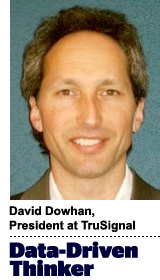 “Data-Driven Thinking” is written by members of the media community and contains fresh ideas on the digital revolution in media.
“Data-Driven Thinking” is written by members of the media community and contains fresh ideas on the digital revolution in media.
Today’s column is written by David Dowhan, president at TruSignal.
For more than a decade, the cookie was a more or less universal way to track users across the Internet.
Faced with today’s multidevice world, we are witnessing a veritable arms race in cross-device tracking as marketers yearn for the same presumptive universal ID that the cookie once provided.
Yet despite innovation in both probabilistic and deterministic technologies for ID matching, marketers are still far from finding a universal standard with sufficient scale, adaptability and reach to keep up with the increasingly fragmented media landscape.
Walled Gardens Everywhere
What we’ve got instead is a litany of competing offerings. Deterministic proprietary IDs exist within walled gardens, but these walled gardens are just that and don’t talk to each other particularly well. As a result, they optimize spend and determine attribution only within the boundaries of a specific platform. Their effectiveness is limited by the size of the platform itself.
As platforms proliferate, so do the IDs. There are social IDs, search IDs, mobile IDs, matching IDs, data management platform IDs, demand-side platform IDs, publisher IDs, TV IDs, IP addresses, hashed emails and cookies, among others.
Marketers need a way to easily execute their marketing strategies, inside and outside the walls of any particular garden or the limits of any particular cookie pool. To date, matching across platforms using a deterministic approach constrains reach, while matching users probabilistically compromises accuracy. The promise of a truly reliable and universal ID is still a far-off dream..
More Than Just A Gardening Problem
While walled gardens present their own technological problems, there are also issues of standardization that must be addressed. This requires at least a semblance of consensus between what are often competitive companies.
We’ve already seen how hard standardization among frenemies can be, especially given recent experiences with hot topics such as fraud and ad blocking. Around thorny problems like viewability and ad blocking, trade bodies and third-party verification providers, including the IAB and MRC, have spearheaded standardization efforts.
It’s not likely that ID matching will standardize in the same way. ID matching is hard. Different platforms have invested millions of dollars in providing their own solutions to the problem, and, moreover, many providers count their ID matching solution among their key competitive advantages. But the largest platform are the least incentivized to give up proprietary IDs in favor of a universal standard.
When it comes to ID matching, different ad platforms are, by nature, at odds with one another about where the problem originates and what the best solution might be. Absent a neutral entity tasked with creating a truly cross-platform universal ID, a solution would have to be spearheaded by individual platforms that find it more advantageous to work together rather than apart. That’s not likely to happen anytime soon since it currently isn’t to anyone’s advantage to do so.
PII To The Rescue?
Oracle recently introduced its own ID graph, which is the latest effort to create an ID that can migrate across multiple channels. The functionality that underlies the ID graph derives primarily from its Datalogix and BlueKai acquisitions, which provide the ability to match offline profiles to online users in a privacy-safe way.
The basis for the match is personally identifiable information. A consumer’s identity is the only constant across all platforms, and it is impossible to reliably predict who someone is without it. The success promised by Oracle’s ID graph comes from directly matching digital profiles to offline PII and constantly updating the graph as consumers move, acquire new devices, get new phone numbers or open new email accounts.
The era of the one-trick cookie is over. But marketers relying upon the tracking within the walled gardens of each new platform that emerges as a proxy will find themselves stuck in a web of increasingly complex cross-purposes and counter incentives.
Follow TruSignal (@TruSignal) and AdExchanger (@adexchanger) on Twitter.












